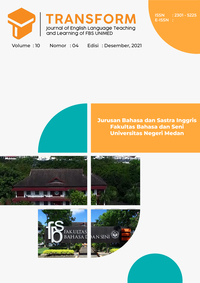Humorous Discourse on Indonesian Students™ Protest Slogans
DOI:
https://doi.org/10.24114/tj.v10i4.44114Keywords:
Humor, Indonesian Students, SloganAbstract
The objectives of this study were to find out what, how, and why humor were realized on Indonesian students™ protest slogans. The method of this research is descriptive qualitative. The data was taken from all the words, phrases, clauses, sentences written in Indonesian students™ protest slogans. The result shows that there are two types of humor found in Indonesian students™ protest slogans, namely collective identities with total number 7 slogans (35%), the effect of participation with total number 6 slogans (30%), frames with total number 5 slogans (25%) and tactics with total number 2 slogans (10%). Collective identities showed that K-Popers, gamers, introverts are not only as community but also as a new power to strengthen a sense of ˜we™ in social movement. Humor also has the effect of participation on enhancing engagement and preventing burnout by including their personal life experience intentionally and explicitly. Indonesian students™ protest slogans showed frames by using some symbols and some analogies to the popularity (music, drama, song title) to attact public interest and the protesters brought or wear some attribute in the movement to establish a repertoire and interpreted as an action to get their message across. There were two dualistic reason of using humor in the societal level. Collective identities as the emphasis on differentiation reflects a strong identification to make it possible to exclude the others, while the effect of participation, frames and tactics act as control or resistance which mean a form of attack and challenge the power and become a new way for communicating among the protesters and to establish a new relationship with the power.Downloads
Published
2023-03-14
Issue
Section
Articles
License
Copyright (c) 2023 Vivi Dwi Tasya, Amrin Saragih

This work is licensed under a Creative Commons Attribution-ShareAlike 4.0 International License.
Authors who publish with this journal agree with the following terms:
- Authors retain copyright and grant the journal right of first publication with the work simultaneously licensed under a Creative Commons Attribution License that allows others to share the work with an acknowledgment of the work's authorship and initial publication in this journal.
- Authors are able to enter into separate, additional contractual arrangements for the non-exclusive distribution of the journal's published version of the work (e.g., post it to an institutional repository or publish it in a book), with an acknowledgment of its initial publication in this journal.
- Authors are permitted and encouraged to post their work online (e.g., in institutional repositories or on their website) prior to and during the submission process, as it can lead to productive exchanges, as well as earlier and greater citation of published work (See The Effect of Open Access).
- This work is licensed under a Creative Commons Attribution-ShareAlike 4.0 International License.

This work is licensed under a Creative Commons Attribution-NonCommercial-ShareAlike 4.0 International License.



